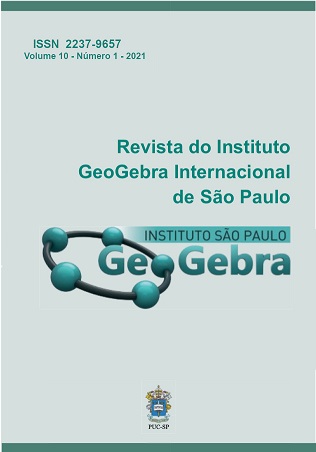Performing a playful/mathematical activity using GeoGebra and Tangram discussed in the light Activity Theory
DOI:
https://doi.org/10.23925/2237-9657.2021.v10i1p129-150Keywords:
GeoGebra, Activity Theory, TangramAbstract
The present article is an introduction to a master's research, to construct the theoreticalmethodological assumptions, being developed together with the Postgraduate Program in Teaching - PPGEn, of the State University of Southwest Bahia - UESB. We bring up the discussion of a mathematical activity: the construction of one of the figures that can be formed with the “pieces” of the Tangram, using the options of isometry in the GeoGebra plane. Initially, we will address the Engestrom Activity Theory (TA). Next, we will briefly explore GeoGebra using isometric options in the plane. Then we will build the figure and analyze it, based on a discussion in the light of Activity Theory, observing the degree of difficulty involved in this process, as well as, we will discuss the mathematical thinking involved in this form of non-traditional construction. In the final considerations, we will discuss how TA will allow the theoretical and methodological perspective of research under construction.References
BORBA, Marcelo de Carvalho; SCUCUGLIA, Ricardo R. da Silva; GADANIDIS, George. Fases das Tecnologias digitais em Educação Matemática: sala de aula e internet em movimento. Belo Horizonte: Autêntica Editora, 2014.
ENGESTRÖM, Y. (2001). Último acesso em 09/07/2020.
ENGESTRÖM, Y. Activity Theory and expansive design. Theories and practices of interation design, 2006.
ENGESTRÖM, Y. Learning by expanding: ten years after. 1999. Disponível em: < http://lchc.ucsd.edu/MCA/Paper/Engestrom/expanding/toc.htm.> Último acesso em 09/07/2020.
ENGESTRÖM, Y. Learning by expanding: an activity-theoretical approach to developmental research. 1987 (Helsinki, Orienta-Konsultit). Versão online, disponível em: < http://lchc.ucsd.edu/MCA/Paper/Engestrom/expanding/toc.htm.> Último acesso 09/07/2020.
ENGESTRÖM, Y; SANNINO, A. Studies of expansive learning: Foundations, findings and future challenges. Educational Research Review, v. 5, 2010.
LEONTIEV, A. N. O desenvolvimento do psiquismo. Lisboa: Livros Horizonte, 1978.
LIMA, Elon Lages. Isometrias. Rio de Janeiro: SBM, 2007.
OLIVEIRA, Marta Kohl. Vygotsky: aprendizado e desenvolvimento: um processo sócio-histórico. São Paulo: Scipione, 1997.
PICCOLO. M.G. Historicizando a teoria da atividade: do embate ao debate. Psicologia e Sociedade. 2012
RIBEIRO, Elizete Maria Possamai et al. Sequência didática: Tangram. Sombrio: IFC, 2012.
SILVA, M. D. F et. tal. Atividades Matemáticas com o GeoGebra. (E-book. Orgs. SILVA, Maria Deusa F & ARAÚJO, Taiane. R. O). Amazon, 2018., n.p.n.
SILVA, M. D. F GeoGebra Materiais. Disponível em: <https://www.geogebra.org/m/apMUMZ7M>. Acesso em: 11/07/2020.
SOUSA, J.; PATARO, P. M. Vontade de saber matemática. São Paulo: Editora FTD, 2014.
SOUTO, D. L. P. Transformações Expansivas em um curso de Educação Matemática a distância online. 2013. 279 f. Tese (Doutorado em Educação Matemática). Universidade Estadual Paulista "Júlio de Mesquita Filho" - UNESP. Rio Claro, 2013a.
SOUTO, D. L. P; BORBA, M.C. Seres humanos-com-internet ou internet-com-seres Humanos: uma troca de papéis? Relime, Vol. 19 (2), Júlio de 2016.
VYGOTSKY, L. Mind em Society. MA: Harvard University Press, 1978.
Downloads
Published
How to Cite
Issue
Section
License
Submission, processing, and publication of articles sent to the journal and registration of the DOI at Crossref is free of charge.
Authors retain their copyright and grant the journal the right of first publication of their article, which is simultaneously licensed under a Creative Commons - Attribution 4.0 International license CC BY that allows others to share the article by acknowledging its authorship and initial publication by the journal.
The GeoGebra journal encourages its authors to register their work with information and communication management systems aimed at researchers, such as Academia.edu, Mendeley, ResearchGate, etc.


 10.23925
10.23925
